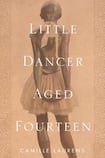
In April 1881, Edgar Degas exhibited a new sculpture at the Salon des Indépendants in Paris. The sculpture, which the artist titled Little Dancer Aged Fourteen, and which was modelled on a young student of the Paris Opera Ballet dance school, caused a sensation. The piece was made of wax, normally just a stage in the process of sculpting, and the statue was dressed in a real ballet tutu, with real ballet slippers and a wig of real hair. It was condemned as ugly, monstrous, repulsive; compared to a monkey, certainly not art.
Now, of course, it is hailed as a masterpiece and, as French author Camille Laurens details in her absorbing publication, the subject of any number of contemporary accounts, many of them fictional: there have been two novels, a television film, even a musical.
While Laurens’s book, a mix of biography, art criticism and personal narrative, is insistently non-fictional – “I need the reality,” she writes, “it underlies my desire” – it stems, as a novel might, from the author’s passion, a years-long fixation on the three-foot statue in the glass case. Each time she enters a museum that houses the sculpture, writes Laurens, “I feel my heart leap.”
To an extent, Laurens’s infatuation mirrors Degas’s own: the artist spent days at the Paris Opera observing the dancers, but he didn’t represent them in sentimental fashion. He painted them backstage, at rehearsal; tired, in contorted positions, without grace.
Laurens suggests, as have others, that Degas was a callous misogynist who took up the position of a voyeur at the opera, interested in revealing its sordid underbelly (the fact that many of the very young ballerinas came from impoverished backgrounds and sex work with the men who frequented the establishment was a necessary reality for earning money) but uninterested in the young women as anything more than the stuff of his art. (Unusually, Degas did not sleep with his models; still he held no affection for them.)
Laurens’s concern is to give the girl, Marie von Goethem, back her personhood, so that the statue will not have “counted for more than the life” and, in this, of course, she diverges from the artist.
Impressionistic portrait
Yet, as she struggles to gather information about the little dancer’s life, to find even the date of her death, the author frets that she, too, is approaching Marie “as an object of study, filled in with anecdotes the way her sculpture is filled in with bric-a-brac”. Her concern is valid: after all it is Laurens who has the power to mould and shape as did Degas, only this time with words, and, certainly, the publication is too impressionistic to merit the category of researched biography.
Nonetheless, what Laurens does achieve is a foregrounding of issues of gender and power: she reminds us that although we remember Degas, the female models, muses and mistresses of art history are given legacy only through the manner in which the male artists have rendered them.
Laurens’s little book sits alongside novelist Marie Darrieussecq’s 2017 Being Here Is Everything, a rendering of the life of German artist Paula Modersohn-Becker; it is also in conversation with John Berger’s 1975 Ways of Seeing, which focused, among other things, on the male gaze in art and imagery.
Her style is less poetic than that of Darrieussecq or Berger, and in Willard Wood’s translation the prose is clear, taut, although, towards the end, it tends towards the overwrought, as she details her depression and anxiety at not being able to tell fully Marie’s story. Her hands tremble as she searches the Paris Archives for records; when she meets a librarian who shares her interest in von Goethem, she is afraid to speak lest her voice quaver.
Scanty facts
Her admitted lack of source material can also become a little wearing, as she fills her publication with “maybes”, “what ifs” and “whys”. In this Laurens was guided by the work of French Nobel laureate Patrick Modiano, whose book attempting to trace the life of an unknown Jewish girl was itself “full of unanswered questions, of unfinished answers”. But sometimes it feels as if she is spinning off into the abyss, particularly in the third and final section, where she seems to be running out of things to say.
Still, even if Laurens doesn’t succeed in filling in all of the blanks, she does provide, as she had hoped, a little reality. What is certain is that Marie von Goethem’s life was a tragic one. Born in 1865 into a large family of poor Belgian immigrants, she was pushed by her laundress mother to leave school early and work in the Paris Opera, where the little girls – known as petits rats – were expected to spend long, punishing hours rehearsing for a meagre salary, as well as earning extra income for their households from prostitution.
Her work as a model for Degas, although hard, was a welcome relief from this, and better paid. But it did not last, as Degas dropped her as soon as he was finished with her, and it did not help her position in life.
Laurens has long been moved by the Little Dancer as a person, not just as a statue. We may not be given all the answers, but this book allows readers to be moved by her too.











